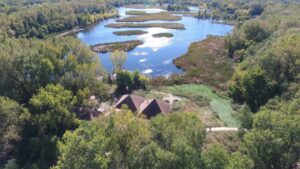
Aerial view of Wood Lake Nature Center
BY DEBRA KEEFER RAMAGE
Summer is for parks and nature
Summer in Richfield is a time to get out and about in your city. Richfield has a lot of options for outdoor activities. The two largest city parks, Veterans Memorial Park, at 6335 Portland Ave., and Wood Lake Nature Center, at 6710 Lakeshore Dr., offer a choice of highly developed and structured areas with sports activities ranging from ice hockey to pickleball, or a very natural setting with trails, a mostly undeveloped lake, and urban wildlife.
Wood Lake was once a recreational lake surrounded by homes. Most of the lake’s water drained during the 1950s, due in part to the effects of the construction of nearby I-35W. The city of Richfield
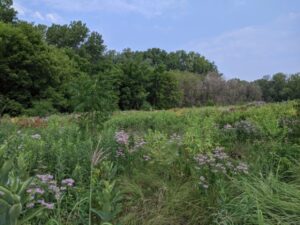
Restoration prairie at Wood Lake Nature Center
founded the Wood Lake Nature Center in 1971.
Wood Lake Nature Center today is a 150-acre park and nature preserve with paved trails and nature trails, boardwalks around the lake, observation shelters, and picnic and other nature-centered recreation areas. It has an indoor, fully staffed interpretive center that offers educational activities and resources to children and families.
Wood Lake Nature Center comprises three distinct types of habitat – cattail marsh, mixed lowland forest, and restored prairie. In order to preserve the natural habitats in the Nature Center, pets, bicycles, skates and skateboards, and picking plants or foraging are all banned on the premises. There is a supportive nonprofit, founded in the early 1990s, called Friends of Wood Lake (FOWL) which raises money and awareness to keep the Nature Center going.
Richfield’s rich history – 1812 to the 1890s
Richfield has a very interesting history. The 1851 Traverse des Sioux treaty, Fort Snelling, “immigrants” from Maine, a flour mill on Minnehaha Creek, 19th and early 20th century farmers markets, and World War II were the main historical forces that shaped Richfield.
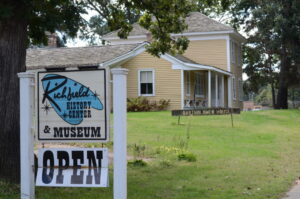
Richfield Historical Society’s Bartholomew House
The adoption of the treaty, allowing settlement of European-Americans west of the Mississippi in what was then the territory of Minnesota, spurred the completion of Fort Snelling, begun decades earlier in 1812.
From the blog Minnesota Historian we learn that “early in Minnesota’s Euro-American history, the first industry of power was flour milling … From before the state’s conception until about 1897, six flour mills were in operation along Minnehaha Creek’s banks. These mills proved to be important historical forces that drove development and further settlement up Minnehaha Creek, thus creating the seedlings of the suburbs of Minneapolis.”
Farmers began moving into the area near Fort Snelling and Minnehaha Creek, and unofficially they began to call the place “Richland Mills,” after a nearby mill. Minneapolis locals Philander Prescott, Willis Moffett and Eli Pettijohn built this mill in 1855 near the spot where Lyndale Avenue crosses Minnehaha Creek (which is today in Minneapolis, but at that time, the city limits ended at Lake Street). Postmaster James Dunmoore, one of those “Maine immigrants,” had opened a post office in 1854 in the same area, and called it Harmony, after his hometown back east.
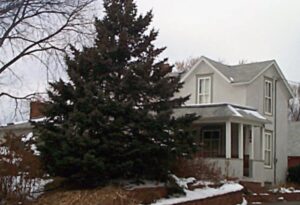
An 1876 house on 66th Street in Richfield
In 1858 the farmers and businessmen of the area, variously called Richland Mills or Harmony, met to form an official township. At that meeting they rejected both names in favor of Richfield, and the mill also decided to change its name to Richfield Mill. For the full story (including the amazing life of Philander Prescott) read “The Rise and Fall of Minnehaha Creek’s Milling Industry” at minnesotahistory.org/post/the-rise-and-fall-of-minnehaha-creek-s-milling-industry.
Another person who was key to Richfield’s future also settled there around the same time. Riley Lucas Bartholomew, a retired general from the Ohio Militia, claimed a large tract of land on the eastern shore of Wood Lake and built a beautiful home there in 1852. When it was complete, he sent for his wife and children, and settled down to become a major civic leader in Minnesota. He built the first church and first school in the area, served as a Hennepin County justice of the peace, was a delegate to the state founding convention, was briefly a state senator, and served in a volunteer company during the Dakota War in 1862.
Bartholomew’s house is still there today, owned and preserved by the Richfield Historical Society and part of its Richfield History Center. The Richfield Historical Society also has a presence at the Richfield Community Center and provides historical exhibits to schools and libraries.
Richfield’s rich history – 1897 to 1950
After statehood and the Dakota War, the township of Richfield grew into a village and eventually a city. The original township and later city of Richfield comprised 63 square miles, as opposed to seven square miles today. Around the turn of the century, the vast majority of this land was in small farms, growing either wheat or other grain for milling in St. Paul, or produce truck farming for the growing urban center of Minneapolis. According to Wikipedia, “Minneapolis became a favorite trading point for market gardeners in 1897 with the building of the modern, covered Second Street Market just two blocks west of Hennepin Avenue and Bridge Square. The market featured a massive platform for gardeners, including Richfield’s sizable contingent, to unload and display produce.”

Richfield Farmers Market
Today the tide has turned, and Richfield itself has an excellent farmers market at Veterans Memorial Park.
The years from 1886, when the first partition ceded parts of Richfield township to form St. Louis Park (an early annexation by Minneapolis in 1867 was the first and biggest loss of acreage) to 1907, when Richfield became a village, saw a shift from farming to being a bedroom community with strong ties to Minneapolis. Further partitions and annexations in 1887, 1889 and 1927 pared off more land, until by the late 1940s the last remaining farm of any size was sold to be developed for housing. Even though there are no more farms in Richfield, here and there an old 19th-century house still stands, such as the one at 1406 W. 66th St., featured on a website called HouseNovel.com, that was built in 1876.
After World War II, returning veterans flooded into Richfield, and developers could barely build houses fast enough. Even today, Richfield abounds in single-family detached housing, although today’s density-driven building boom may change that.
Richfield today and prospects for the future
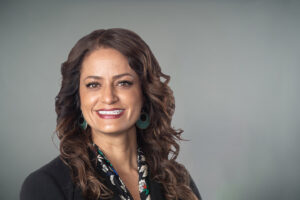
Former Richfield Mayor Maria Regan Gonzalez, now director of equity initiatives at M Health Fairview
Up until the early 2000s, Richfield remained a suburban, and not very diverse, small city. The population peaked at nearly 50,000 in 1970, then began to slowly decline, leveling off at around 35,000. Around the late 20th century, other forces created demographic changes in race, ethnicity, age, household size and income levels. For instance, the population percentage identified as “white” in the 2000 census was 79%. This declined to 63% in 2010, and again to 59% in 2020. The largest growing ethnic demographic was “Hispanic, all races,” which grew from 6% to 18% in the same 20-year period.
Richfield is a hospitable home to Hispanic residents, with many successful small businesses under Hispanic ownership, and one of four public K-5 schools being a dual language (English-Spanish) school. In 2018, Richfield elected Ward 3 Council Member Maria Regan Gonzalez as mayor, making her the first Latina mayor in the state of Minnesota. She served a four-year term, being succeeded by the current Mayor Mary Supple, a retired public-school teacher. In the U.S. Congress, Richfield is represented by Ilhan Omar, a Somali immigrant, who is widely and enthusiastically supported by Richfield voters.






















